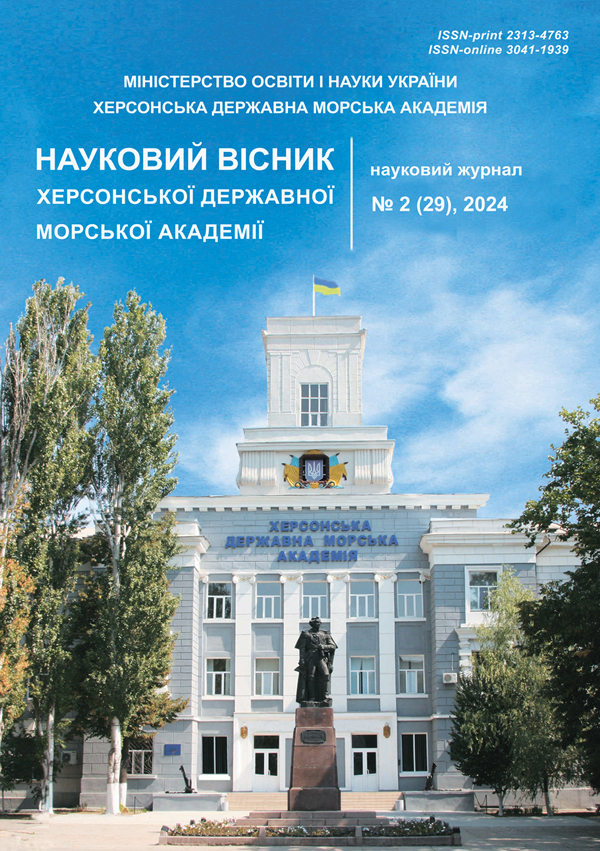МОДЕЛЮВАННЯ ПРОЦЕСІВ ПІДВИЩЕННЯ НАДІЙНОСТІ НАВІГАЦІЙНОГО КОМПЛЕКСУ ЗА ДОПОМОГОЮ ДУБЛЮВАННЯ ЙОГО ЕЛЕМЕНТІВ
https://doi.org/10.33815/2313-4763.2024.2.29.164-177
Анотація
Метою статті є дослідження та математичне моделювання того, як можна підвищити надійність навігаційного комплексу шляхом дублювання елементів у складі системи. У представленій статті розглядаються деякі питання визначення стійкості технічних систем насамперед з точки зору їх надійності (ймовірності безвідмовної роботи). Розглянуто низку актуальних задач стосовно підвищення надійності систем за рахунок дублювання їх елементів. Проведена оцінка різних схем дублювання елементів систем і здійснено їх математичне моделювання. Для систем, що складаються з нерівнонадійних елементів досліджено правомірність заміни їх надійностей деяким середнім значенням. Показано, що така заміна дає дещо завищені значення надійності системи, і має сенс тільки при невеликій дисперсії значень надійностей (ймовірностей безвідмовної роботи) елементів системи. При високих значеннях дисперсії різко зростає відносна помилка розрахунку надійності системи (>10%). Представлено також приклад більш-менш глибокого дублювання найменш надійних елементів системи, що значно (більше ніж удвічі) підвищує надійність системи в цілому. Визначено напрями подальших досліджень, такі як використання поняття повної ймовірності та Байєсових (апостеріорних) ймовірностей відповідних гіпотез.
Посилання
2. International Maritime Organization (IMO). International Convention for the Safety of Life at Sea (SOLAS), 1974.
3. Wahlström, M., Forster, D., Karvonen, A., Puustinen, R., Saariluoma, P. (2019). Perspective-Taking in Anticipatory Maritime Navigation – Implications for Developing Autonomous Ships. In Proceedings of the 18 the International Conference on Computer and IT Applications in the Maritime Industries, Tullamore, Ireland, 25–27 March 2019; 191–200.
4. Wreathall, J. (2011). Monitoring – A critical ability in Resilience Engineering. In Resilience Engineering in Practice: A Guidebook; Hollnagel, E., Paries, J., Woods, D. D., Wreathall, J., Eds.; Ashgate Pub Co.: Surrey, UK.
5. Praetorius, G., Hollnagel, E. (2014). Control and Resilience Within the Maritime Traffic Management Domain. J. Cogn. Eng. Decis. Mak., 8, 303–317.
6. Praetorius, G. (2014). Vessel Traffic Service (VTS): A Maritime Information Service or Traffic Control System? Understanding Everyday Performance and Resilience in a Socio-Technical System under Change. Ph.D. Thesis, Chalmers University of Technology, Gothenburg, Sweden.
7. Schröder-Hinrichs, J.-U., Praetorius, G., Graziano, A., Kataria, A., Baldauf, M. (2015). Introducing the Concept of Resilience into Maritime Safety. In Proceedings of the 6th Resilience Engineering Association Symposium, Lisboa, Portugal, 22–25 June 2015.
8. Smith, D., Veitch, B., Khan, F., Taylor, R. (2013). Using the FRAM to Understand Arctic Ship Navigation: Assessing Work Processes During the Exxon Valdez Grounding. TransNav Int. J. Mar. Navig. Saf. Sea Transp., 12, 447–457.
9. Wahlström, M. (2019). Resilience on the seven seas: perspective-taking in anticipatory ship navigation. In Proceedings of the 8th REA Symposium Embracing Resilience: Scaling Up and Speeding Up, Kalmar, Sweden, 24–27.
10. Van Westrenen, F., Praetorius, G. (2014). Maritime traffic management: a need for central coordination? Cognition, Technology & Work, 16(1), 59–70.
11. Aven, T., Andersen, H. B., Cox, T., Droguett, E. L., Greenberg, M., Guikema, S., Kröger, W., Renn, O., Zio, E. (2015). Risk Analysis Foundations. Soc. Risk Anal.
12. Ayyub, B. M. (2015). Practical Resilience Metrics for Planning, Design, and Decision Making. ASCE-ASME J. Risk Uncertain. Eng. Syst. Part Civ. Eng. 1. https://doi.org/10.1061/AJRUA6.0000826.
13. Ayyub, B. M. (2014). Systems resilience for multihazard environments: definition, metrics, and valuation for decision making. Risk Anal. Off. Publ. Soc. Risk Anal. 34, 340–355. https://doi.org/10.1111/risa.12093.
14. Smith, D., Veitch, B., Khan, F., Taylor, R. (2015). An Accident Model for Arctic Shipping, in: Proceedings of the ASME 2015 34th International Conference on Ocean, Offshore and Arctic Engineering. Presented at the OMAE 2015, St. John’s, NL, Canada.
15. Hollnagel, E. (2011). RAG – The resilience analysis grid. In Resilience Engineering in Practice: A Guidebook; Hollnagel, E., Paries, J., Woods, D. D., Wreathall, J., Eds.; Ashgate Pub Co.: Surrey, UK.
16. Jackson, S., Ferris, T. L. J. (2013). Resilience Principles for Engineered Systems. Syst. Eng., 16, 152–164.
17. Jackson, S., Ferris, T. L. J. (2016). Designing Resilient Systems. In Proceedings of the NATO Advanced Research Workshop on Resilience-Based Approaches to Critical Infrastructures Safeguarding, Azores, Portugal, 26–29June 2016; 121–144.
18. Madni, A. M., Jackson, S. (2009). Towards a Conceptual Framework for Resilience Engineering. IEEE Syst. J., 3,181–191.
19. Woods, D.D. (2015). Four concepts for resilience and the implication for the future resilience. Reliab. Eng. Syst. Saf., 141, 5–9.
20. Sterbenz, J. P. G., Hutchison, D., Cetinkaya, E. K., Jabbar, A., Rohrer, J., Schöller, M., Smith, P. (2010). Resilience and survivability in communication networks: Strategies, principles, and survey of disciplines. Comput. Netw., 54, 1245–1265.
21. Sterbenz, J. P. G., Hutchison, D., Cetinkaya, E. K., Jabbar, A., Rohrer, J., Schöller, M., Smith, P. (2014). Redundancy, diversity, and connectivity to achieve multilevel network resilience, survivability, and disruption tolerance. Telecommun. Syst., 56, 17–31.
22. Cheng, Y., Todd Gardner, M., Li, J., May, R., Medhi, D., Sterbenz, J. P. G. (2014). Optimised heuristics for a geodiverse routing protocol. In The 10th IEEE/IFIP international conference on Design of Reliable Communication Networks (DRCN), Ghent, Belgium.
23. Feller, V. (1984). Vvedennia v teoriiu ymovirnostei ta yii zastosuvannia. (Vols. 1–2). M.: Svit.
24. Heche, F. E. (2019). Teoriia ymovirnostei i matematychna statystyka. Uzhhorod: PP «AUTDOR-ShARK».






